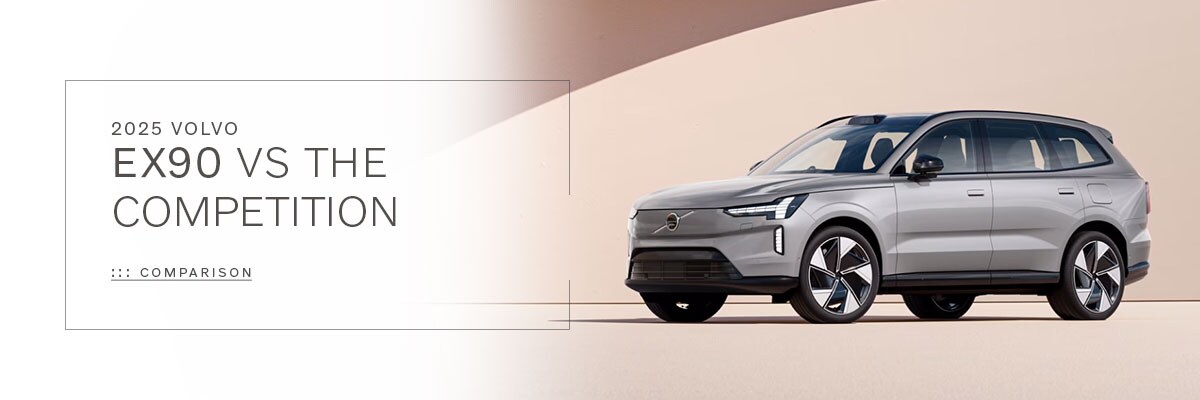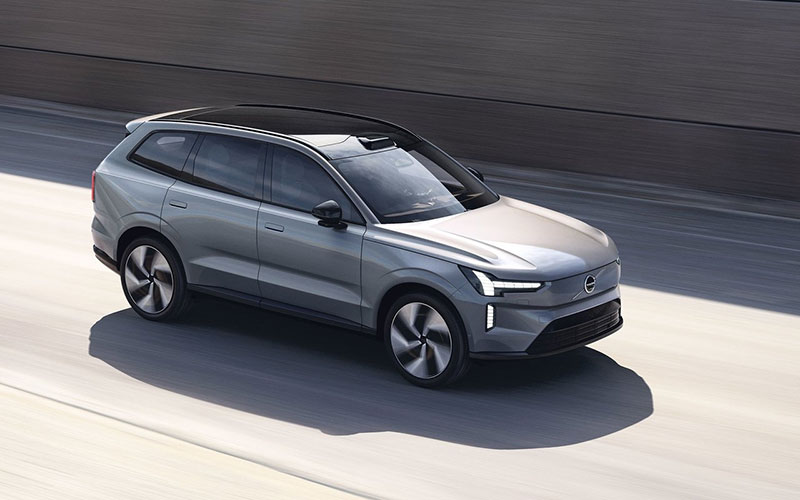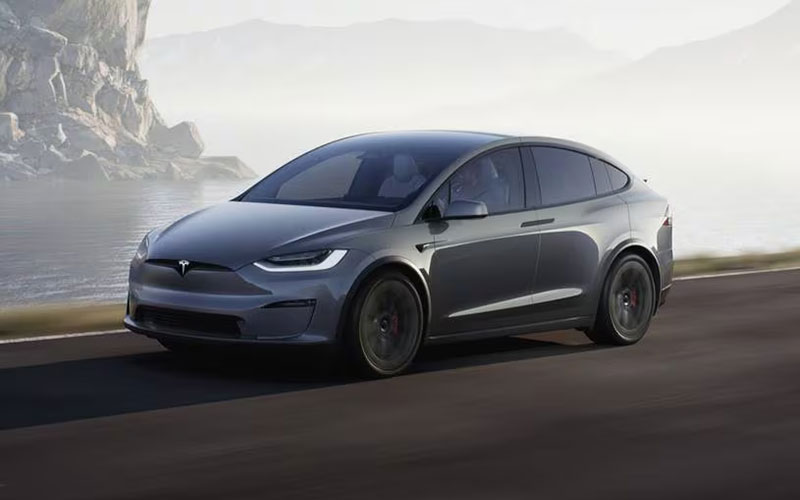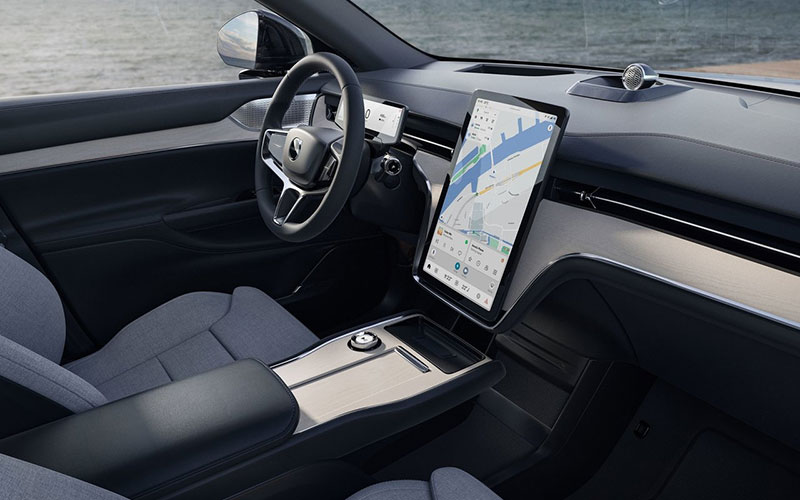
As Volvo moves closer to an all-electric lineup, the EX90 is the brand's new flagship. This three-row SUV is a showcase for the advanced technology and impressive performance that we can look forward to from Volvo going forward. But Volvo isn't the only brand moving in this direction, and there are some competitors to the EX90 out there. Since this market segment is still very new, we put together a guide to help you navigate what your options are and how competitors measure up to the EX90.
Volvo EX90 VS Mercedes-Benz EQS SUV
 |  | |
|---|---|---|
| 2025 Volvo EX90 Twin Motor Performance Ultimate | VS | 2024 Mercedes-Benz EQS 450 4MATIC |
| $90,640 ✓ | MSRP | $107,400 |
| 510 HP / 671 LB-FT TQ ✓ | Horsepower / Torque | 335 HP / 590 LB-FT TQ |
| 4.7 seconds ✓ | 0-60 Time | 5.8 seconds |
| 308 miles | Range | 330 miles |
| 10 hours ✓ | Charging Time (Level 2) | 14 hours |
| 4,850 pounds ✓ | Towing Capacity | Not rated |
| 4-zone ✓ | Climate Control | 2-zone (4-zone optional) |
| Standard ✓ | 7 Seats | Optional |
| Standard ✓ | Soft Close Doors | Optional |
| Standard ✓ | Front Massage Seats | Optional |
| Standard ✓ | Heated 2nd-Row Seats | Optional |
Scroll Right to View Information
Mercedes-Benz got into electric vehicles relatively early, and the EQS SUV is the brand's three-row offering. Since the EX90 comes with standard all-wheel drive, we've selected the EQS 450 4MATIC, although the price difference is pretty vast, so we're going with the Performance drivetrain and Ultimate trim of the EX90 to make it a little closer. The standard EX90 drivetrain still produces more horsepower and gets to 60 mph quicker than the EQS, but the Performance drivetrain really drives home the point that the EQS offers pretty lackluster performance for the price. The EQS does have a slightly bigger battery, which gives it a few more miles of range. But this battery also charges at a slower rate, and it takes much, much longer to charge up all the way, completely offsetting the slight range advantage, and then some. Towing is a pretty obvious win for the EX90 as well, no contest there.
Conventional wisdom would tell you that the Mercedes is probably more expensive because it comes with more equipment, since that extra money certainly isn't going to performance. But a closer look at what comes standard will quickly dispel that idea. A third row of seats is standard in the EX90, while Mercedes will charge you more for it. Soft-closed doors are still not necessarily found on every six-figure luxury vehicle yet, and while the EQS does offer them, they cost extra. That's nice and all, but getting them as standard equipment, which is the case with the EX90 Ultimate, is certainly much better. Front massage seats are usually a lot more common, and the surprise here isn't that the EX90 has them as standard, it's that they cost extra on the EQS. Heated front seats have at least become common enough that they're included in the price of the EQS, but heated 2nd-row seats will cost you extra. Volvo throws them in at no additional charge. In all, it's a bit of a mystery what all that extra goes to on the Mercedes.
Volvo EX90 VS Tesla Model X


Tesla was the first modern all-electric vehicle manufacturer to gain a real market share, and as such, it's impossible to overlook in a comparison. But these comparisons are always needlessly difficult, since Tesla isn't especially forthcoming about details. For example, the price listed at the top of the official Tesla website for the Model X isn't actually the price, it's what the price would ultimately be after tax credit savings, and even projected fuel cost savings are factored in. You have to go into the builder and deselect options just to see the true price. Obviously, these same savings apply to any electric vehicle, but no other manufacturer operates this way. In reality, the price difference between the Model X and the EX90 comes in at exactly $5, but the official Tesla site makes it appear that the Model X is about $10,000 cheaper. And this brings us to the first major problem with the Model X, the company itself. Tesla is regularly plagued by recalls, and reliability data is hard to come by, since Tesla is the only major manufacturer that regularly refuses to participate in reliability studies. This lack of transparency should be concerning to any potential EV buyers.
What we can say about the Model X is that it has a range of 326 miles, according to the EPA. This is more than the 308 that you get from the EX90, but just like with the Mercedes, the charging time is slower by enough that a slightly longer range isn't such a great advantage. In this case, it takes 12 hours to fully charge, as opposed to 10 hours for the Volvo. Some of this probably comes from the fact that the Model X is still effectively a 2015 model built from a 2012 design. There have been new options added and software updates, but after a decade on the market, there have been no major design updates and no announced plans for any. To revisit the issue of price, it's worth noting that the 7-seat EX90 is only similar in price to the 5-seat Model X, and adding a third row of seats to the Tesla costs an additional $3,500. Another big advantage of the EX90 is that just has normal doors. The gullwing design of the Model X rear doors is prone to frequent issues, and a redesign was required in 2017. Many owners continue to complain about problems, but Tesla keeps quiet about just how extensive this problem is.
Winner - Volvo EX90

After looking at the competition, it's clear that the EX90 is the segment's clear leader. Better tech, better performance, and better equipment all make for a highly desirable vehicle. Try though the competition might, the EX90 sets a new standard. Reserve your EX90 with Motorcars Volvo Cars now.